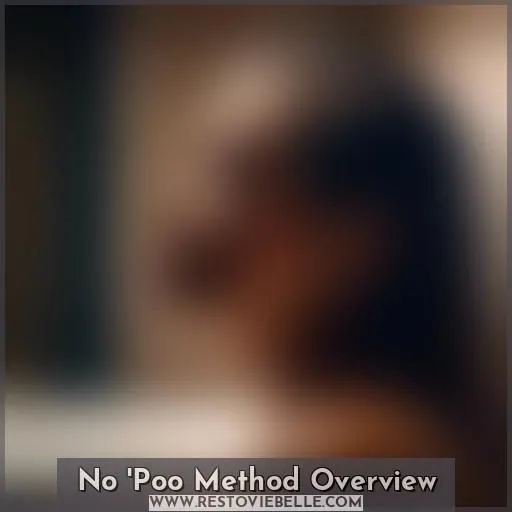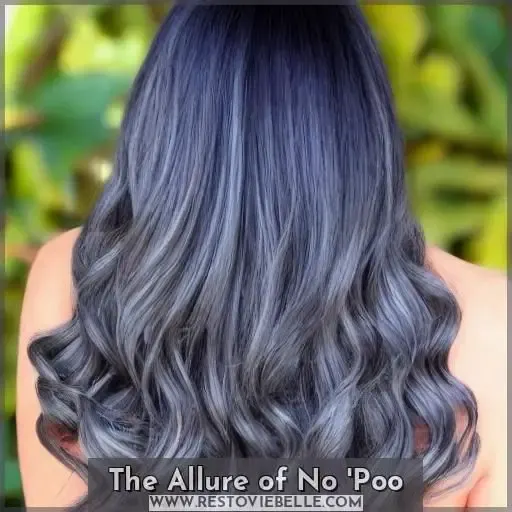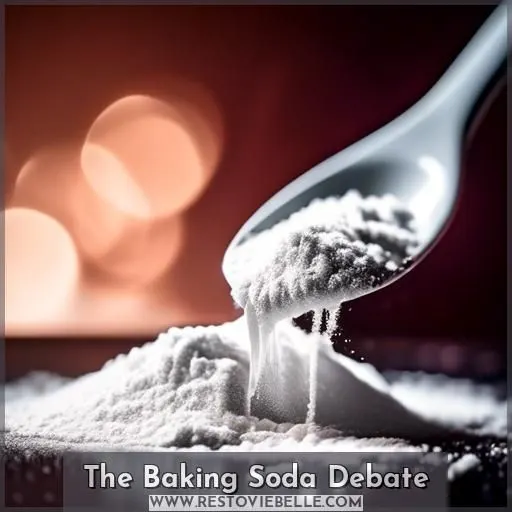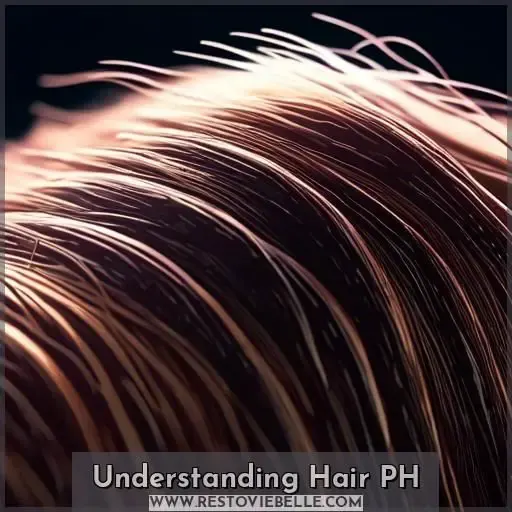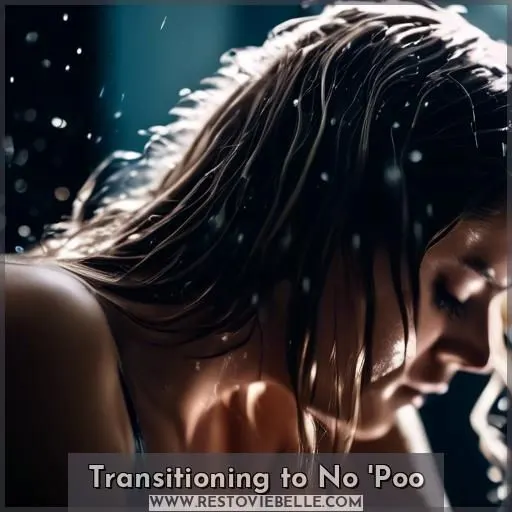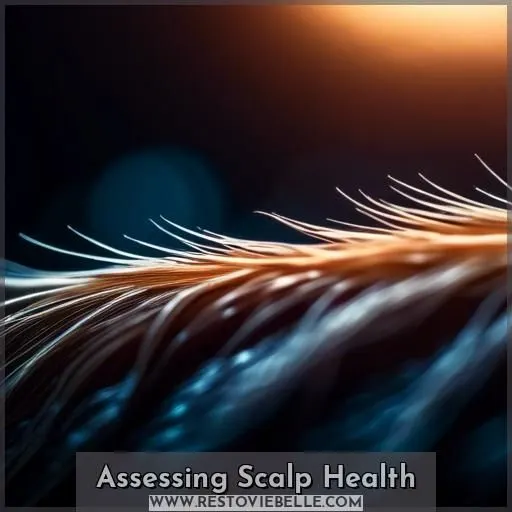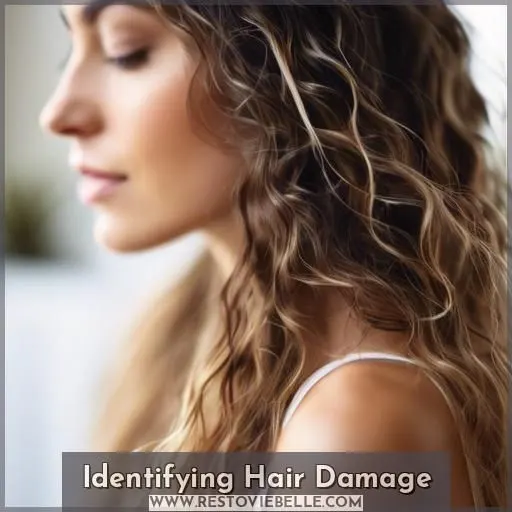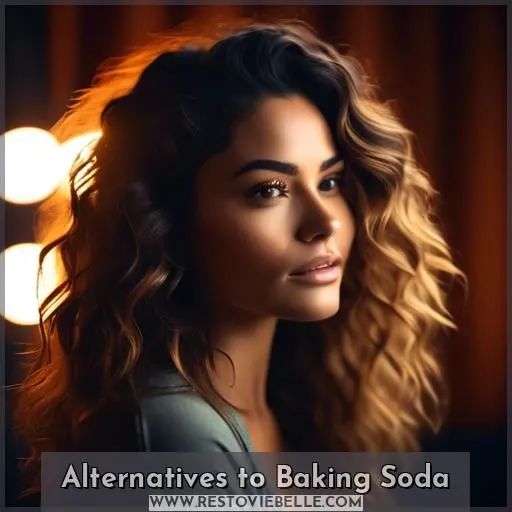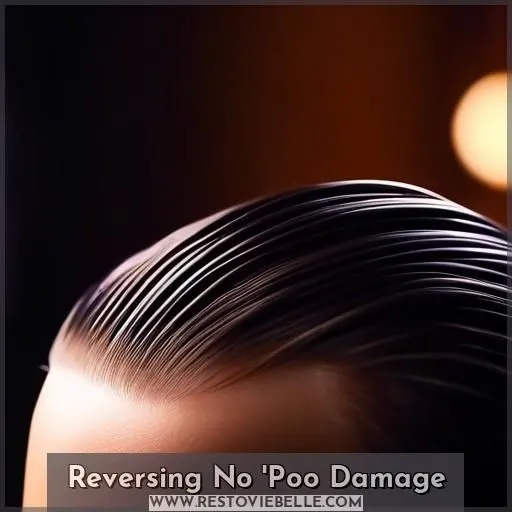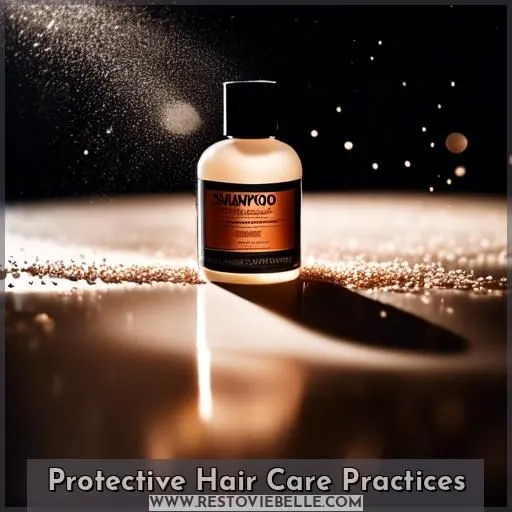This site is supported by our readers. We may earn a commission, at no cost to you, if you purchase through links.
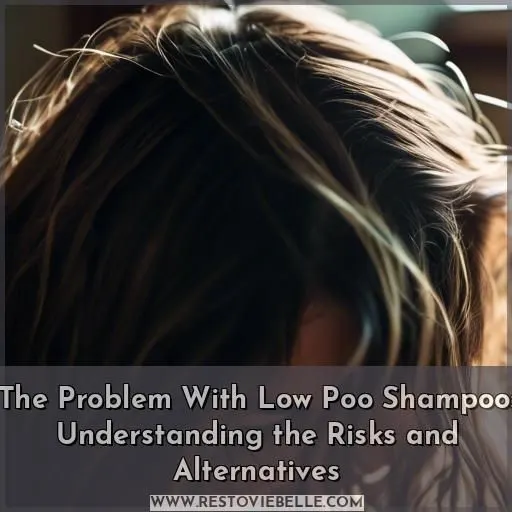
The no ‘poo method, which uses baking soda and vinegar, can lead to dryness, brittleness, and breakage in your hair. This is due to the highly alkaline nature of baking soda, which can disrupt your hair’s natural pH balance. Despite its promise of healthier hair, it may not be the best choice for everyone.
Moving to no ‘poo can also be challenging, with a potential adjustment period of greasiness and scalp irritation. It’s important to monitor your scalp health and adjust your ingredients and mixtures as needed.
If you’re experiencing hair loss, it may be a sign that the no ‘poo method isn’t working for you. Consider exploring alternative cleansing agents or gentle wash routines.
Table Of Contents
- Key Takeaways
- No ‘Poo Method Overview
- The Allure of No ‘Poo
- The Baking Soda Debate
- Understanding Hair PH
- Transitioning to No ‘Poo
- Assessing Scalp Health
- Identifying Hair Damage
- Alternatives to Baking Soda
- Reversing No ‘Poo Damage
- Protective Hair Care Practices
- Frequently Asked Questions (FAQs)
- How does no-poo shampoo clean hair without using harsh chemicals?
- Can I use no-poo shampoo on different hair types, such as curly or fine hair?
- How often should I use no-poo shampoo to avoid damaging my hair?
- Are there any natural ingredients that can replace baking soda in no-poo shampoo?
- How can I reverse the damage caused by using no-poo shampoo for an extended period?
- Conclusion
Key Takeaways
- The No-Poo method, which uses baking soda and vinegar, can lead to dryness, brittleness, and breakage in your hair due to the highly alkaline nature of baking soda.
- The adjustment period to the No-Poo method can be challenging, with a potential adjustment period of greasiness and scalp irritation.
- If you’re experiencing hair loss, it may be a sign that the No-Poo method isn’t working for you.
- Consider exploring alternative cleansing agents or gentle wash routines.
No ‘Poo Method Overview
Welcome to the realm of No ‘Poo hair care! This technique entails cleansing your hair with baking soda and water, followed by a rinse with apple cider vinegar. It’s a budget-friendly, do-it-yourself approach to maintain the cleanliness and health of your hair, with the added advantage of being harmless and environmentally conscious.
Baking Soda and Vinegar Basics
Diving into the ‘no poo’ method, you’re swapping your shampoo for a mix of baking soda and apple cider vinegar. This duo aims to be your hair clarifier and scalp exfoliator, with baking soda opening the hair shaft during the washing phase and vinegar sealing the deal in the rinsing process.
If your locks cry out for mercy, consider ingredient alternatives like bentonite clay for a gentler touch.
Cost-Effective Hair Care
The No ‘Poo Method is a popular, cost-effective hair care option that involves washing your hair with baking soda and vinegar. Here’s what you need to know:
- No ‘Poo Alternatives: Baking soda and vinegar aren’t the only options. Explore natural cleansing agents like bentonite clay, raw honey, and essential oils.
- Transition Challenges: Prepare for a 7-day interval between hair washing. Use headbands and hats to conceal greasiness.
- Scalp Irritation: Be aware of potential irritation, especially if you have sensitive skin.
- Hair Loss Potential: While rare, some users have reported hair loss after switching to No ‘Poo.
- pH Balance Maintenance: Maintain a balanced pH to avoid damaging your hair.
- Natural Hair Care: Embrace the journey of natural hair care, which can be cost-effective and environmentally friendly.
- Cost-Effective Hair Care: Save money by using natural shampoo and conditioner alternatives.
- Rosemary Lavender Leave-in Conditioner: Consider using a leave-in conditioner to nourish your hair and maintain its health.
The Allure of No ‘Poo
The allure of No ‘Poo lies in its promises of healthier hair and environmental and economic benefits. Many people are drawn to the idea of washing their hair with natural ingredients like baking soda and vinegar, believing it will lead to cleaner, healthier hair while being kinder to the planet and their wallets.
Promises of Healthier Hair
The No ‘Poo method, which involves washing hair with baking soda and vinegar, has gained popularity for its inexpensive, nontoxic, and DIY approach to hair care. Proponents claim that it can stretch washes out to every 4 days, leaving hair feeling clean, healthy, and easier to style.
However, concerns have arisen about the potential damage caused by baking soda. Some users have reported dry and brittle hair after using the method, which was initially dismissed as a result of incorrect usage. Over time, baking soda can cause hair to become porous, brittle, and parched, leading to breakage and frayed ends. The high alkalinity of baking soda can also disrupt the hair’s natural pH balance, making it more susceptible to damage.
To mitigate these risks, some users recommend using alternative natural cleansing agents or gentle wash routines.
Environmental and Economic Benefits
The No ‘Poo Method promises not just healthier hair, but also environmental and economic benefits. By using sustainable alternatives like baking soda and vinegar, you’re opting for DIY hair masks made from eco-friendly ingredients. The cost comparison is significant, as low poo shampoo can save you money in the long run. Plus, choosing ethical shampoo options reduces your environmental impact.
The Baking Soda Debate
The baking soda no poo method has gained popularity due to its cost-effectiveness and environmental benefits. However, the long-term effects of using baking soda as a hair cleanser can be damaging. Some users have reported dry and brittle hair after using baking soda, which the author initially dismissed, believing others were using the method incorrectly. However, the author herself experienced significant damage to her hair, with short sections becoming porous, brittle, and parched.
The baking soda’s alkalinity can open the hair shaft, leading to increased brittleness and breakage over time. While vinegar rinses can help restore some balance, they also put hair through a harsh process. To avoid these risks, consider moving to alternative cleansers like bentonite clay or exploring gentle wash routines. Remember, gentle hair care is key to maintaining scalp health and preventing damage.
Understanding Hair PH
Understanding the pH of your hair is essential for maintaining healthy and lustrous locks. The inherent pH of hair is mildly acidic, ranging between 4.5 and 5.5 on the pH scale. This acidity aids in shielding the hair from external influences and maintains the cuticle layer smooth, preventing moisture loss and damage.
Using products that are excessively alkaline or acidic can disrupt this equilibrium, leading to problems such as frizz, dullness, and increased porosity. It’s essential to select hair care products that are pH balanced, as they’re formulated to function effectively with your hair’s natural pH level.
Importance of PH Balance
Understanding the significance of pH balance in hair care is essential. Shampoos are formulated to be mildly acidic to preserve the hair’s well-being. Baking soda, however, is highly alkaline and can harm hair over time. This damage can result in porous, weak, and dehydrated hair that’s susceptible to knots and tangles.
To prevent such damage, consider using shampoo bars, natural hair care products, or apple cider vinegar rinses diluted with filtered water.
Risks of Alkaline Treatments
Grasping the significance of pH balance is paramount, but veering excessively towards alkalinity can wreak havoc on your tresses. Here’s what you might encounter:
- Alkaline harm leading to hair weakness and breakage.
- PH imbalance causing scalp irritation and dandruff.
- Excessive use of alternative cleansers depleting natural oils.
- Bentonite clay hair masks as a milder alternative for all hair types.
Transitioning to No ‘Poo
When you switch to the No ‘Poo method, anticipate a period of adjustment where your hair may feel unusually oily as it acclimates. Coping with this oiliness requires patience and exploring natural cleansers to determine what’s most effective for your scalp and hair.
Adjustment Period Expectations
Shifting to the No ‘Poo method can be a tricky process, as it necessitates adapting to a new hair care routine. The adjustment period can vary depending on the individual’s hair type, scalp health, and the frequency of previous shampooing. During this period, it’s essential to be patient and persistent, as the scalp may need time to adjust to the new method.
One of the primary concerns during the shift is product selection. It’s imperative to choose the correct ingredients and mixtures, such as baking soda, apple cider vinegar, bentonite clay, and raw honey, to guarantee the best results. For those with sensitive scalps, it’s essential to be cautious and adjust the ingredients as needed to avoid irritation or damage.
Scalp irritation can be a common issue during the shift, as the scalp may need time to adjust to the new hair care routine. It’s imperative to monitor the scalp for any signs of irritation, such as redness, itching, or flaking, and adjust the products accordingly. In some cases, it may be necessary to use a gentle scalp treatment or consult a dermatologist for advice.
Hair loss is another concern during the shift to the No ‘Poo method. While the method is generally safe for most people, some individuals may experience hair loss due to changes in the scalp’s oil production or the hair’s structure. It’s essential to maintain a balanced diet and ensure proper hydration to support hair growth and minimize hair loss.
Protective hairstyles can also help minimize hair loss and damage during the shift. Styles like braids, buns, and updos can help protect the hair from breakage and damage. Additionally, using gentle hairbrushes and avoiding tight hairstyles can help prevent breakage and damage.
The No ‘Poo method requires a mix of ingredients that can be kept for up to a week at a time. It’s imperative to mix the ingredients in the correct order and apply them to dry hair, massaging them into the scalp. The mix should be left on for 5 minutes before rinsing thoroughly with cool water. If needed, a raw honey conditioner can be used after rinsing.
Traveling with the No ‘Poo method can be challenging, as the mix can be difficult to carry and may not be suitable for all types of travel. It’s imperative to plan ahead and consider using alternative methods, such as sulfate-free, low-sudsing shampoos and silicone-free, water-soluble conditioners, for travel.
Managing Greasiness
As you adopt the no ‘poo method, you may encounter oily hair and scalp discomfort. This could be caused by the adjustment period and the altered product components. To address oiliness, attempt rinsing your hair thoroughly with cold water and applying a raw honey rinse.
If you embrace a crunchy lifestyle, consider incorporating essential oils into your regimen. Bear in mind that perseverance and consistency are crucial during this adaptation phase.
Assessing Scalp Health
Evaluating scalp health is paramount when embracing a low-poo shampoo regimen. The scalp plays a pivotal role in regulating oil production, and alterations in this equilibrium can result in imbalances that impact hair health.
Indicators of imbalance encompass excessive oiliness, dryness, and irritation. It’s imperative to monitor these signs and modify the routine accordingly to preserve a healthy scalp and encourage optimal hair growth.
Oil Production Changes
You’ve been experimenting with the No ‘Poo method, which involves washing your hair with baking soda and vinegar, and you’ve noticed some changes in your scalp health. Your hair has become greasier, and you’ve experienced some oil buildup. This is a common concern when changing to a no-poo routine, as your scalp may take time to adjust to the absence of traditional shampoo.
The No ‘Poo method is designed to allow your scalp to regain its natural balance and promote healthier hair by eliminating harsh chemicals and sulfates found in many shampoos. However, it’s important to remember that everyone’s hair is unique, and what works for one person may not work for another. Some people may find that their hair becomes greasier during the change, while others may notice a reduction in oil production over time.
To manage the greasiness, you can try using a bentonite clay mask to clarify your hair before switching to the No ‘Poo method. This can help remove buildup and prepare your scalp for the change. Additionally, you can experiment with different ratios of baking soda and vinegar to find the right balance for your hair type.
If you’re concerned about the oil buildup, you may want to think about using a gentle shampoo or conditioner once a week to remove excess oil and keep your scalp clean. Remember, the goal is to find a routine that works best for your hair and scalp health. It may take some trial and error to find the right balance, so don’t be discouraged if you need to make adjustments along the way.
Signs of Imbalance
Signs of imbalance in your scalp health can include dry hair, hair breakage, scalp irritation, and hair loss. If you’re using a low poo shampoo, like the No ‘Poo method with baking soda and vinegar, you might notice a vinegar smell, which can be a sign that your hair is being put through a harsh process.
It’s imperative to monitor these signs and adjust your hair care routine accordingly to maintain a healthy scalp and hair.
Identifying Hair Damage
It’s crucial to recognize the indicators of hair damage when using a low-poo shampoo. Be vigilant for variations in texture and breakage, as well as elevated dryness and fragility. These indications may suggest that your hair isn’t receiving the appropriate blend of nourishment and attention it necessitates to maintain its vitality.
Texture and Breakage
You’ve reached the next phase of your hair care adventure, where we explore the realm of texture and damage. As you now comprehend, porosity profoundly influences the well-being of your hair.
It’s imperative to uphold a harmonious pH balance to safeguard the protein composition of your hair. Furthermore, scalp distress can precipitate hair loss, so vigilantly monitor for any indications of discomfort.
By grasping these concepts, you’ll be well on your way to achieving a more robust and resilient mane.
Dryness and Brittleness
If you’re experiencing dryness and brittleness after switching to low poo shampoo, it’s crucial to pinpoint the underlying cause. Dry scalp and scalp irritation can stem from a vitamin deficiency or scalp sensitivity. Skin irritation may also play a role.
To address these issues, consider adding a mild shampoo to your routine, or experiment with a scalp treatment or oil to nurture your hair and scalp.
Alternatives to Baking Soda
If you’re looking for alternatives to baking soda in the No ‘Poo method, there are several natural cleansing agents that can be used to clarify your hair and scalp. These include tea tree oil, sugar, rosemary, bamboo extract, and neem oil. These ingredients can help remove buildup, balance natural oils, and promote healthy hair growth.
If you prefer a more gentle approach, you might consider using a natural shampoo with ingredients like shikakai or reetha, which can cleanse your hair without stripping it of natural oils. Additionally, you could experiment with homemade cleansers using ingredients like chickpea flour or soapnut berries.
Natural Cleansing Agents
After recognizing the havoc baking soda can wreak on your tresses, you’re likely seeking natural alternatives that are kinder to your locks. Consider ingredients that soothe scalp sensitivity while promoting hair growth, without the risk of hair loss. Product recommendations often include gentle botanicals and nourishing oils, which can cleanse effectively while respecting your hair’s delicate balance.
Gentle Wash Routine Options
If you’re looking for gentle wash routine options as an alternative to baking soda, there are several natural ingredients you can investigate. Here are four options to contemplate:
- Bentonite clay: This clay is known for its detoxifying properties and can be used to clarify your hair and scalp. Mix it with water to create a paste, apply it to your hair, and rinse it out after a few minutes.
- Apple cider vinegar: Diluted with water, apple cider vinegar can help balance your scalp’s pH, close the hair cuticle, and smooth the hair cuticle, making it easier to detangle and manage.
- Raw honey: Honey is a natural conditioner that can help nourish your hair and scalp. Mix it with water and apply it to your hair after shampooing, leaving it on for a few minutes before rinsing.
- Essential oils: If you’re looking for a more fragrant option, consider incorporating a few drops of your favorite essential oils to your shampoo or conditioner for a pleasant scent and potential benefits.
Reversing No ‘Poo Damage
If you’ve experienced damage from the No ‘Poo method, restorative treatments can help improve your hair’s condition. Reintroducing conventional shampoos, especially those that are sulfate-free, can also aid in returning your hair to a healthier state.
Restorative Treatments
If you’ve experienced damage from the No ‘Poo Method, don’t despair. There are restorative treatments that can help repair your hair.
Start by addressing hair porosity, as this can affect how your hair absorbs and retains moisture. Consider using a deep conditioning treatment or a protein-rich mask to strengthen your hair.
To combat scalp irritation, try using a gentle, fragrance-free shampoo or a scalp treatment. For product buildup, try using a clarifying shampoo or a vinegar alternative like apple cider vinegar or lemon juice.
Reintroducing Conventional Shampoos
If you’ve incurred harm from the No ‘Poo Method, it’s time to contemplate reintroducing conventional shampoos. Detergent-free shampoos can be a mild alternative, but they may not furnish the thorough cleansing your hair requires. Natural hair care remedies like castor oil, olive oil, and soil can also assist, but they may not be adequate to undo the damage.
Be receptive to investigating disparate options, and bear in mind that your hair’s well-being is worth the expenditure.
Protective Hair Care Practices
When contemplating prudent hair care regimens, it’s imperative to select brushes that are benign to your hair and scalp. Embracing protective hairstyles can also shield your strands from harm and contribute to the preservation of overall hair well-being.
Choosing Gentle Brushes
Selecting the appropriate brush is essential for preserving the health of your hair. Here are four tips to assist you in choosing the optimal brush for your requirements:
- Boar bristle brushes: These brushes are crafted from natural boar bristles and are acclaimed for their capacity to disperse natural oils throughout your hair, eradicating greasiness at the roots and capturing excessive oils on the bristles. They’re also delicate on your scalp and assist in evenly distributing your scalp’s sebaceous oil on your hair, serving as a natural conditioner.
- Detangling techniques: When brushing your hair, exercise gentleness and commence from the ends, gradually progressing to the roots. Employing a wide-tooth comb can also mitigate breakage and tangles.
- Scalp massage: A gentle scalp massage while brushing your hair can stimulate hair growth by augmenting blood flow to the hair follicles. Utilize your fingertips or a scalp massager to apply light to moderate pressure, moving in modest circles across your scalp.
- Brush type: Opt for a brush with pliable bristles that won’t harm your hair. For individuals with thick, coarse, or curly hair, round boar bristle brushes provide tension during blow-drying, contributing to the smoothing of the ends of your hair.
Selecting Protective Styles
If you’re considering the No ‘Poo Method, don’t forget about protective styles! Headbands can put tension on your hair, leading to breakage. Opt for hair accessories that don’t tug, like silk bonnets or hair wrapping. Protective braiding can also help prevent damage. Remember, being gentle is essential for hair care.
Frequently Asked Questions (FAQs)
How does no-poo shampoo clean hair without using harsh chemicals?
No-poo shampoo cleans your hair by using natural alternatives like apple cider vinegar and baking soda, which gently remove dirt without stripping natural oils, leaving your locks liberated and living their best life.
Can I use no-poo shampoo on different hair types, such as curly or fine hair?
No-poo shampoo can be used on different hair types, including curly and fine hair. However, adjusting to no-poo may be more difficult for those with fine or thin hair, as it can become oily more quickly. For curly hair, using a conditioner or oil before applying shampoo can help reduce the stripping effect.
If you have fine hair, you may need to thoroughly clean your hair first with a bentonite clay mask before switching to no-poo.
How often should I use no-poo shampoo to avoid damaging my hair?
To prevent damage to your hair while using no-poo shampoo, it’s crucial to determine the appropriate frequency for your hair type. The key is to find the right interval that benefits your hair without causing damage or excessive greasiness.
For some individuals, cleansing once or twice a week may be suitable, while others may require less frequent cleansing. If you have an oily scalp, you may need to wash more often, but for the majority of people, washing every 7-8 days instead of every 5-6 days can be a good starting point.
Hair varies among individuals, so it’s important to experiment and identify what works best for you.
Are there any natural ingredients that can replace baking soda in no-poo shampoo?
Bountiful, beneficial bentonite clay and apple cider vinegar can cleverly kick baking soda to the curb, offering a gentle, effective cleanse that keeps your locks luscious and liberated from harsh, hair-harming habits.
How can I reverse the damage caused by using no-poo shampoo for an extended period?
To reverse the damage caused by using no-poo shampoo for an extended period, you can try using natural ingredients like olive oil, apple cider vinegar, or honey on your hair. These ingredients can help nourish your hair, smooth out rough strands, and restore shine.
Additionally, you can try using a gentle, moisturizing shampoo and conditioner after washing your hair with baking soda to help restore its natural pH balance.
It’s also important to avoid harsh chemicals and styling products that can further damage your hair, and to be gentle when brushing or combing to minimize breakage.
Conclusion
The no ‘poo method, which relies on baking soda and vinegar, can be a double-edged sword. While it promises healthier hair, it may lead to dryness, brittleness, and breakage due to its highly alkaline nature. The adjustment can be challenging, with potential greasiness and scalp irritation.
If you’re experiencing hair loss, it’s time to explore alternative cleansing agents or gentle wash routines. Don’t let the allure of low-poo shampoo blind you to the potential risks.

